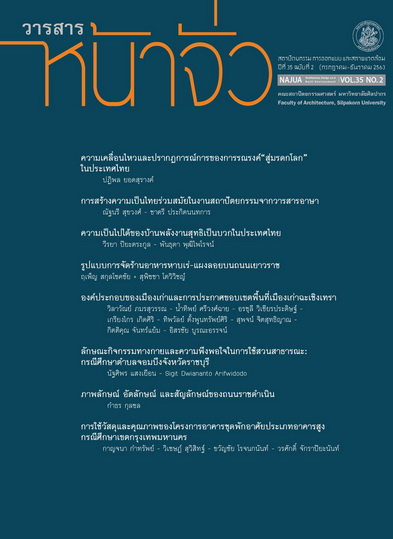Possibility of Net Positive Energy House in Thailand
Keywords:
Net Positive Energy House, Solar House Design, Positive Energy TargetAbstract
Climate change stems from carbon dioxide released from electricity generation, transportation, and industrial sectors. If buildings can produce electricity from renewable sources such as solar energy in the amount that can cover household usage and electric vehicle (EV) charging, it will contribute to decreasing fossil fuel usage, and consequently would alleviate the problem of global warming. This research aims to investigate the possibility of the present house design to be developed as “Net Positive Energy Houses”, producing more energy than they consume, and can support one EV charging within one year. The study started from literature review of the definitions, key design factors, analysis of energy consumption and generation. Two prototype houses with different design concepts were selected. Both have similar floor area around 200 m2. The first one was the DEDE Rak Fah 2, an energy conservation house developed by the Ministry of Energy, designed based on a passive design concept. The second one was the SENA Oxy smart with prefabricated construction systems, equipped with air conditioners and PVs on the roof, located in SENA Park Ville. The estimation of the whole-building energy target was simulated by Revit version 2020, and the energy generation was estimated by PV Watts Calculator. The results showed that it required the PV installation of both houses 9.50-10.26 kWP for the whole-building energy and one EV charging. The energy for one EV was 6,110 kWh/yr. The study also further investigated the reduction of PVs installation cost by using LED lamps instead of fluorescent lamps, reducing total PV installation to 8.36-9.5 kWP. It was noticed that the roof configuration of Sena house can be installed less PV than that of Dede house with 15.58 kWP and 21.66 kWP in order, although both had about the same total floor area. Then the gable roof 30o (aligned Northern to Southern) was designed instead of the hip roof. The result indicated the PV installation can increase from 15.58 kWP to 25.08 kWP. This implies the importance of roof design to achieve the maximum production. The surplus energy can be sold to other buildings through smart grid systems in the future.
References
- German Sustainable Building Council. (2018). DGNB System Criteria Set New Construction Building Version 2018. Stuttgart: n.p.
- King Mongkut’s University of Technology Thonburi. (2017). Rai Ngan Cha Bab Somboon Karn Seuk Sa Karn Chai Pha Lang Ngan Nai Rod Yon Fai Fah Prom Kor Moon Pued Ti Gum Karn Chai Rod Yon Fai Fah Klong Karn Karn Suek Sa Tek No Lo Yee Yarn Yon Fai Fah. (In Thai) [Completely Report for Energy Consumption of Electric Vehicle, Behavior and Technology Study Project]. Retrieved April 11, 2021, from https://bit.ly/3vUGPuX
- Ministry of Energy. (2011). Pan A Nu Rak Pa Lang Ngan 20 Pee (2554 – 2573 B.E.). (In Thai) [Energy Efficiency Plan; EEP 2011]. Bangkok: n.p.
- Ministry of energy. (2017). Ku mue Peuy Prae DEDE Rak Pha Rang Ngan. (In Thai) [DEDE Energy Conservation House User Manual]. Retrieved November 30, 2020, from https://bit.ly/3xXPlv3
- Mitsubishi Electronics. (2021). 3D Move Eye Human Sensor (MSZ-LN13VF (R/B/V)). Retrieved February 15, 2021, from https://bit.ly/3vYQKQ9
- Residential Energy Service Network. (2018). Home Energy Rating System (HERS) Explained. Retrieved January 10, 2021, from https://bit.ly/33A4x3n
- Sena Development. (2019). Sena Solar House Oxy Smart Type. Retrieved October 15, 2019, from https://bit.ly/3hiRGeb





